Stock Market Crash: How the Worlds Worst Market Timer Succeeded Buying at the Worst Times
Have you ever met someone who was adamant a stock market crash was coming? The same person who told you not to invest in the stock markets? You know the person, someone paralyzed by fear thinking that if they buy high, the market will drop and if they buy low, the market will drop.
Stock market crashes are impossible to accurately predict, despite what those tv psychics advertise. If it were possible to predict, every actively managed stock funds would have bet against the market in 2008 and made their investors millions. But that didn’t happen because, like you and I, they weren’t able to predict the markets either.
If your a person who’s paralyzed by stock market crash fear, read the following story about Bob from America, the world’s worst market timer. Bob decided to invest his hard earned money into the stock market at the worst possible times. Here is Bob’s story:
Bob began his career as a car salesman in 1970, the year the AMC Gremlin was introduced. The Gremlin was a hot seller and Bob made lots of commission pushing that nifty little 2-door. Bob decided to start saving his commissions and planned to invest in the stock market. The problem was he was paralyzed by fear. He decided only to invest when the market was going up. He knew investing in single company stocks was super risky, so he decided to buy shares in a Vanguard S&P 500 Index Tracker Fund (Bob was a smart guy who was ahead of his time).
By the end of 1972, the Gremlin’s popularity had fizzled but sales of the AMC Spirit and Concord were steady so Bob was able to save a whopping $6,000 (that’s about $32,000 in today’s money). Bob instructed Sal, his stockbroker, to buy $6,000 of the Vanguard S&P 500 Index Fund.
During the 1973-74 stock market crash, the S&P dropped by 50% and despite being struck by investment anxiety, Bob made a pledge to himself that no matter what happened, he wouldn’t sell his index funds because he wouldn’t know when to re-buy.
Bob continued to save but was hesitant about investing due to the 1973-74 stock market crash, so he sat out of the market despite watching stock prices rebound magnificently. In August 1987, Bob’s entire $46,000 in savings went to Sal along with instructions to buy more of the S&P 500 index fund. Shortly after Bob’s big purchase, another stock market crash occurred and the market fell by 30%. Bob was cursing his bad luck but again, stood by his promise not to sell, no matter what happened.
Bob continued to save and found the courage to invest an additional $68,000 in December of 1999. Bad judgment Bob. Yet another stock market crash occurred resulting in a 50% drop that lasted until 2002. By this time, Bob was bald from worry and wondered if he’d be better off taking his savings to the casino and betting red or black on the roulette wheel. In the end, he decided, in for a penny, in for a pound and decided not to stray from his “buy and hold no matter what” strategy.
Every month Bob would receive an investment statement in the mail but he purposefully threw them right into the bin. He feared that if he opened the statement and saw bad news, he make might a rash decision to sell.
In October 2007, Bob was eyeing retirement and decided to stomach one last market investment. He withdrew savings of $64,000 and gave Sal his final index fund buy order. The market proceeded to fall by 50%. Sal thought Bob was the unluckiest investor he’d ever met.
Here’s a summary of Bob’s poor timing:
| Investment Date | Correction % | Invested $ |
| 12/1972 | -48% | $6,000 |
| 08/1987 | -34% | $46,000 |
| 12/1999 | -49% | $68,000 |
| 10/2007 | -52% | $64,000 |
| Total Investment: | $184,000 |
After Bob’s last day at the car dealership, he went home and plucked up enough courage to open his retirement account statement. Surely the last stock market crash must have depleted his retirement savings. So how much did Bob have in his account?
$1.1 million!
Bob could barely believe his eyes. His vigilant saving, investing and self-will not to sell had paid off. Even though the market had experienced many corrections throughout the decades, compounding interest and dividend reinvestments had become Bob’s best friends.
What Bob didn’t know was that if he’d invested on an annual basis throughout the years instead of in lump sums (also known as cost averaging), Bob’s retirement account would have been valued at over $2.3 million!
What can we learn from Bob?
- Most of us are like Bob. We have no idea when the stock market crash will happen or how to time the market so we should keep investing monthly during the highs and the lows
- Don’t look at your investment statements, especially during stock market crashes when our sell panic emotion goes into overdrive
- Stay focused on your long-term goals
- Invest in low-cost tracker funds. Fees devour returns
Want to read the full study on Bob? Harvard Business Review Article















